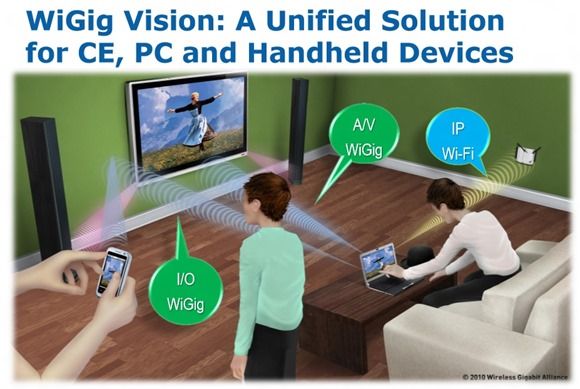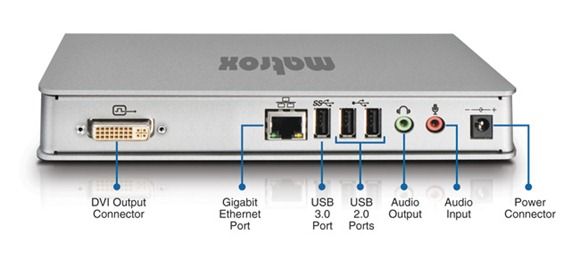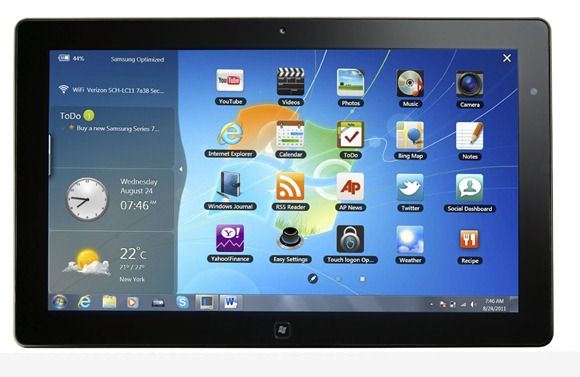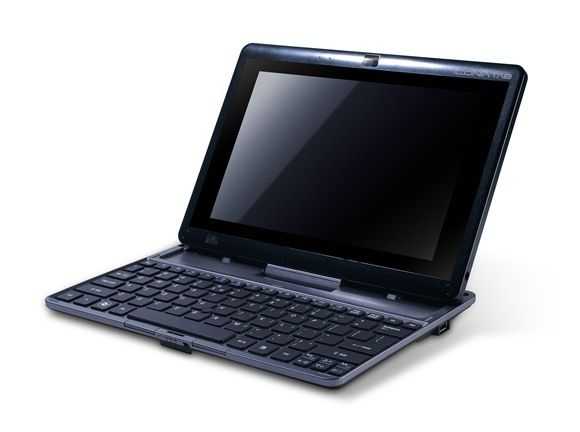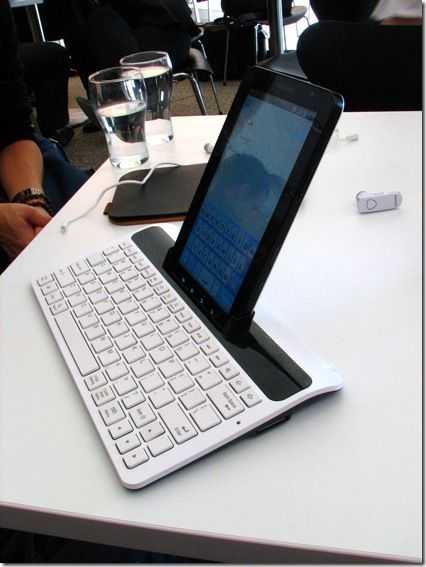We’ve just had the inside information on the WiGig docking standards that are going through draft approval right now. Expected to be fully approved by end of 2013, the formal line on product availability is that you’ll see devices in 2014 but we spoke to one parts vendor that tells us we’ll see a WiGig-enabled Ultrabook at CES 2013 and that you’ll see products based on draft standards in Q1 2013. We’re believers that Ultrabooks can replace desktops for most people through on the with the use of docking solutions but when it’s wireless, it’s much better!
Tag Archive | "docking station"

Matrox DS1 Thunderbolt Dock Launched At $249
Posted on 04 June 2012
Looking for a guide price for Thunderbolt docks that might fit with that Acer S5? The Matrox DS1 thunderbolt docking station has just been announced. Breaking out a DVI port, one USB3.0, 2x USB2.0 a Gig-Ethernet port and audio interfaces, it will certainly help reduce clutter. But for $249 is it worth it?

Series 7 Slate Price Drop. Get Slate, Dock and Keyboard for $1199
Posted on 30 January 2012
Ultrabooks are all about getting full computing power in a lightweight, stylish and long-battery life solution. Core i3, i5 and i7 ‘ultra low voltage’ platforms are the core of these systems but there are a few non-ultrabook solutions that use this platform and still provide a thin and light solution. One of them is a true alternative. It’s a tablet/docking station combo that I’ve written about before. The Samsung Series 7 XE700 and today the prices are looking a lot better than they did a month ago.
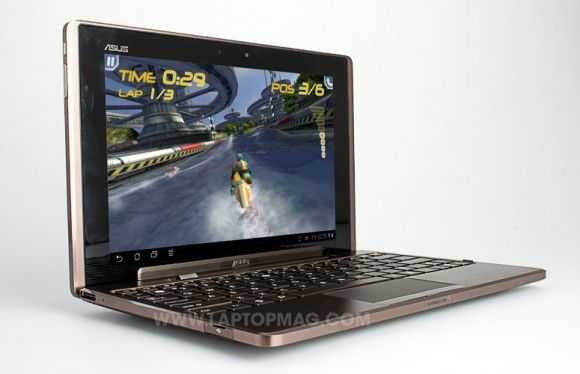
Eee Pad Transformer Trips Up in Productivity Scenarios.
Posted on 25 April 2011
UMPCs, we’re not shy to say, are still important. They’re becoming more important too as people realise that there is a life for devices between 4 and 10 inches. UMPCs offer something that you can rely on to give you a high quality work and web experiences with the minimum of brick walls and maximum compatibility and flexibility.
Unfortunately for pro-mobile fans, the number of true UMPCs has dropped to near-zero with only large-screen windows tablets getting any sort of attention. It’s the Android and IOS tablets that are getting the lions share of attention and development funds though and we are now in a position where we need to keep an eye on the desktop and mobile worlds for solutions that could satisfy our needs.
I’ve done extensive testing and research on the smartbook market over that last 18 months with devices like the Compaq Airlife 100 and Toshiba AC100 but I haven’t found anything that I could call pro-quality. While the industrial designs and computing hardware reach acceptable levels, the immature operating systems and applications truly limit capability and introduce inefficiencies and risk.
Honeycomb, the tablet-oriented version of the Android system is the next-in-line for major testing and the Asus Eee Pad Transformer is the ideal product to test it with.
Although I haven’t yet been able to get hold of a Transformer as my Amazon UK order was delayed to June, I have been carefully reading between the lines of the many reviews that are out there. I’m trying to get a feel for web experience, applications, keyboard usage, connectivity and battery life along with an idea about how those ‘HD’ apps are coming on.
So far, I am not seeing an acceptable solution being presented.
While a lot of reviewers seem impressed with the price and design of the tablet, keyboard and docking feature, the battery life and general usability of Honeycomb, there seem to be issues with Web (once again, not the full desktop internet experience) performance and applications. It’s the latter that concerns me the most as it will take the longest to fix and relies on a healthy Honeycomb ecosystem to even seed. I’m also not so impressed with the price. It may be cheaper than other tablet options but it’s still an inflated price for what you’re getting. Finally, at 1.3KG, it weighs 130gm more than the Aspire one 522 that i’m using right now that has nearly double the CPU processing power and 3D graphics that just don’t compare along with an OS developed for professional use and a huge range of professional software available.
Keyboard – Good ID
In general, the keyboard and mousepad are getting good reports. A good level of mousepad/OS integration ensures that the unit is not relying on touch input when docked. The battery in the keyboard unit is used to recharge the tablet battery (a very inefficient, but cheap, way of using an extended battery) and the USB ports are of limited use. Mass storage and external mice are supported but don’t exptect to be able to plug in a webcam, usb headset or many other common USB accessories that ‘just work’ under Windows.
Battery Life – So-So.
In total, the Asus Eee Pad Transformer returns around 9hrs in tablet mode. Some reviews are reporting down to 6hrs. Usage in docked mode is going to depend on whether you dock the device when the tablet is fully charged as the battery in the docking station will try to re-charge the battery in the tablet while also powering the system. The battery to battery re-charge process is going to cost 20-30% of energy. From results I’ve seen the maximum you can expect from the docked unit is about 16hrs which, with a 48wh battery, shows that ARM-based devices ultimately rely on screen, wifi and engineering to get the best out of them, just like X86-based devices. I haven’t seen any screen-off, wifi on figures yet (always-on mode) but am hoping for at least 4 days. If the Transformer is very well engineered, that figure should go up to the 7-10 days range. ElectricPig indicates that the Transformer loses about 10% of battery with Wifi on in a screen-off, syncing on scenario. Assuming that’s about 10hrs of idle, it indicates a reasonable always-on, Wi-Fi connected capability of about 4 days (tablet only) or about 6 days (tablet and dock.) That beats the Toshiba AC100 my a big margin.
Web Experience – Not FIE
Tabbed browsing is nice, but many reviewers are focusing on this , and the Flash 10.2 experience as a big step forward. For productivity users, these are entry-level features. While thre aren’t too many details in the reviews I’ve seen so far there are indications that the quality of the browsing experience is compromised. I’m particularly interested to hear how Google Docs works with the keyboard. AnandTech reports ”occasional issues’ that include a poorly formated Reddit front page.
Applications – Back to the Smartphone
As I mentioned above, this is the major issue for Android Smartbooks and it’s not one that manufacturers can solve. It will only resolve itself when Honeycomb gets traction, proves numbers and drives teams to develop quality software over a period of months. At the current rate of change in software, we’don’t expect Honeycomb to offer anything like a serious 3rd party productivity application range until at least late in 2011.
Other issues to consider.
- No 3G / 4G
- No VGA output (for projectors, monitor compatibility)
- Video playback not smooth (as reported by a number of website reviews.)
- Some reviews are reporting speed slow-down after a couple of hours of use.
Sidenote: The Anandtech review is an interesting read that explores the idea of continuous client and smartphone-based modular solutions.
Summary.
For smartphone and tablet users, the Asus Eee Pad Transformer must appear quite exciting. It did for me too but I knew there would be issues. The issues of application availability will haunt every attempt at an Android productivity device for at least the next 6 months, probably longer, but if manufacturers fail to capitalise on battery life possibilities and if Google can’t update Honeycomb to finally support a Chrome-like internet experience, there will be limited reason to accept these attempts into the realms of profesional environments and little enthusiasm for creating rich, high quality, professional applications. The few points mentioned above are obvious failings but there are other hidden items that will rise to the surface as people truly start to try these devices out for productivity. Think about multi-user capability for example. Disk encryption, memory upgrade, VGA ports and 3G support are just a few more to consider.
I’m disappointed in the battery life reports, video playback issues, weight and web experience that I’m reading about so far. So much so that i”ve decided to skip the Eee Pad Transformer. I will try to get hold of a review sample but it won’t be something I’ll take on board into my work life. Like the Airlife, AC100, Atrix and other attempts, there’s so much missing, so many brick-walls, so few applications that I don’t expect any major progress until later in the year. The Transformer proves the point that Honeycomb can move in the right direction and as a tablet device, it may well be good value but for pro-mobile users, I’m not recommending it.
Caveat -These thoughts based on my experience with smartbooks, my own hands-on with the Transformer, feedback from contacts and information available in the public domain. Find full reviews of the Asus Eee Pad Transformer in our product page. Reader, owner feedback is encouraged below.
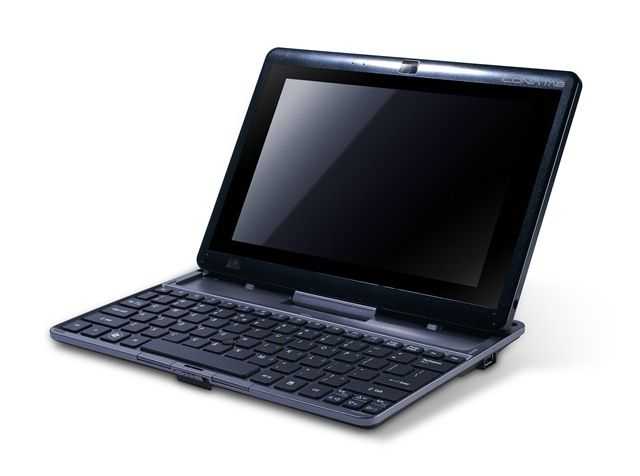
Acer Iconia Tab W500 – Specs Look Good. Weight and Battery Life Don’t
Posted on 25 February 2011
The product page for the Acer Iconia Tab W500 is now live and populated with links, specs, gallery and videos.
I’ve been through the details with a fine toothcomb and on one had I’m quite excited about a sub 1KG tablet with an acceptable CPU, good GPU, hi-res wide-view screen, UMTS and docking station for 599 Euro (current average online prices, Germany) but when you look at the weight / battery life ratio, it isn’t that good. Acer have only managed to squeeze in a 36Wh battery which means you’re looking at 3-4hrs usable battery life. Add the dock (which doesn’t look like it’s built for the road!) and you’re up over 1.5KG.
Taken as a tablet only, it actually looks like an interesting proposition. With CPU power up at the top end of the netbook range and GPU that blows away anything based purely on Intel netbook platforms it should perform smoothly. 2GB of RAM and Windows Home Premium give it media serving capability. Throw in the UMTS/HSDPA and it gets even more exciting.
See the W500 gallery for more.
At the end of the day, and specifications list, I’ve a feeling that this is going to work well as a hot-desking solution. It should serve well as a home desktop for anyone not getting involved with hundreds of browser tabs or video editing and the grab-and-go capability means it can be used in a more casual manner now and again. It looks fun too!
For ultra mobile PC fans though, it’s just too heavy. An upgraded 1.25KG Asus 1015PN with 6hr battery would be a much better choice for true mobile computing.
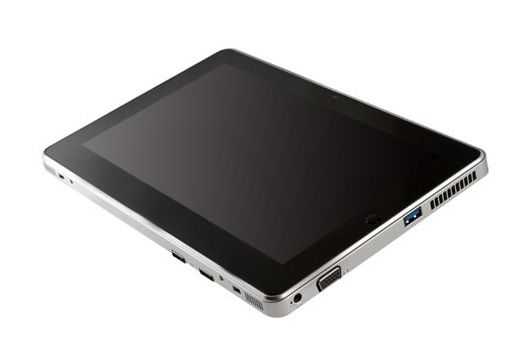
Gigabyte S1080 Windows Tablet with Docking Ports. Hands-on Video.
Posted on 25 January 2011
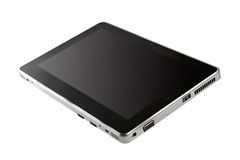 Gigabyte launched a new Tablet PC at CES that we haven’t reported on yet. My fellow MeetMobility podcaster Sascha of Netbooknews has just had hands-on today so it’s worth plugging his video and talking a little about the device.
Gigabyte launched a new Tablet PC at CES that we haven’t reported on yet. My fellow MeetMobility podcaster Sascha of Netbooknews has just had hands-on today so it’s worth plugging his video and talking a little about the device.
Firstly, we’re talking about 10 inch capacitive touchscreen tablet at 900gm running Windows 7 on a netbook platform with the N570 (2×1.66Ghz) CPU. Usefully, there’s a built-in mouse area and left-and-right mouse buttons which is perfect for two-handed use. Unfortunately, there’s no digitiser so you’re left with a slight mismatch between the pen-focused Windows 7 and the finger-focused touchscreen. It’s something we’ve seen in a few devices recently and we don’t like the trend. HP have it right with the dual-mode 500 slate as do Lenovo and Motion Computing.
Interestingly though, the device isn’t aimed at vertical markets. The press-release from Gigabyte (Jan 6th) sates: “The S1080 is designed to be the ultimate mobile device to fit the demanding needs of consumers who need a high-performing multitasking slate that offers the full productivity of a PC, inch OK, taken from that angle, they might have it right. There’s a suite of overlay software and, i’m pleased to say, provision for a docking port that looks, based on the size of those connectors, to offer serious connectivity. Wouldn’t it be nice to have a PCI-Express slot in the docking station. Gigabyte are no stranger to the idea of PCI Express but it has far more value on a powered docking station. Later in the press release, Gigabyte allude to a more professional customer: “The large hard drive also makes it the perfect device to load custom business and enterprise applications”
We seem to have an interesting product here for either consumer or enterprise markets…until we look at battery life which brings a huge question mark to the table. N570 at 900gm means max 30Wh battery and that means 3-4hrs in my opinion. I’ve tested the 1KG N350 (Samsung, also dual-core Atom) and that didn’t get much past 4hrs. Still, with the dock in use, this could be something for hot-desking and hot couching! I’m looking over at the Fujitsu U820 that is powering this post and thinking, hmm, upgrade time? A 10 inch screen next to my desktop screen would certainly be more useful on my desk than the 5.6 inch-er I’ve got here. Let’s hope for 2GB and Windows Home Premium and the possibility to swap the HDD for an SSD.
Here’s the video from Netbooknews.
via – Netbooknews

Galaxy Tab HDMI Dock Review
Posted on 15 December 2010
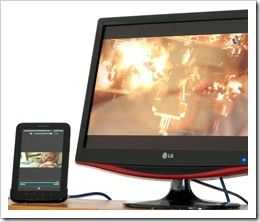 Sometimes we’re lucky in Europe, sometimes not. With the Galaxy Tab we’re generally lucky because Germany was one of the first countries to get mass-market availability. It’s also one of the first places to get the Galaxy Tab HDMI Docking Station. Model number: ECR-D980
Sometimes we’re lucky in Europe, sometimes not. With the Galaxy Tab we’re generally lucky because Germany was one of the first countries to get mass-market availability. It’s also one of the first places to get the Galaxy Tab HDMI Docking Station. Model number: ECR-D980
Recommended price is 49,90 Euros but let me just say this now don’t buy it for that price. Not only is it available for much less (I bought it for 36 Euro) but it simply isn’t worth 50 Euro. It’s nothing much more than a stand and a break-out cable and once you’ve bought the HDMI cable to go with it, you’re looking at a lot of money just to get the digital video signal from one connector to another.
Yes, there’s no HDMI cable included which completely caught me off-guard. I ended up heading out to the local electronics shop where, of course, the lowest cost cable was out of stock. I paid 29 Euro for a mini HDMI to HDMI cable which is again, too much. The other thing you’ll need is the power cable from your original Galaxy Tab because again, it’s not provided and you need it to activate the HDMI port. That means if you want to charge the Tab somewhere other than the dock or use the cable for PC connectivity, you need to remove it from the dock. A royal pain in the arse and certainly not user friendly. The other cable problem has to do with the original USB cable. It’s all of about 50cm long and just doesn’t reach to most plug locations. Samsung have not thought this one through.
One more thing, there’s no 3.5mm audio cable proved either but I guess that won’t surprise you now.
As you’ll see in the images, there are just the three ports on the dock. Mini HDMI, 3.5mm audio and the power cable input. Analogue video is not exposed on the docking port so you’ll have to buy another cable for that (17 Euro street price) which means you’ll have to remove the device from the dock, stop charging and connect the A/V breakout cable. Again, not elegant. The build quality is good and the base-located speaker openings are routed well.

You can also flip the Tab into landscape mode and use the dock as a stand…
Video Playback
Once you’ve got over the cable issue and got things connected up, you’ll see various output styles that depend on device orientation and application control. For example, the home screen flips to fill the screen when you put the device in landscape mode. YouTube plays in full-screen regardless of device orientation. Games, such as Asphalt 5 HD, only show in landscape mode and video playback through the local video player or through the DLNA ‘AllShare’ player always show in full-screen.
I tested the output on two devices. One, an LG digital TV, the other, an LG monitor (both 1080p capable) and got two different results in terms of quality. It also highlighted some audio issues that you need to be aware of.
The LG digital TV worked well and seemed to display in a ‘native’ resolution although there were a few lines missing at the top and bottom of the screen. If the monitor has 1080 vertical resolution and the Tab, 1024, why are there lines missing? There’s some overscan or scaling issue here on my TV. Playback of videos from the local storage was great and a 1080p trailer played just beautifully although without sound due to the lack of AC3 down-conversion. I’ll talk more about that in a minute. Google Earth was fun too although the up-scaling from 1024×600 definitely shows up on-screen! I even tried a racing game. By holding the dock and device in landscape mode you can use the Tab as a controller and watch it on the screen. It’s fun but not that practical with two cables hanging out of the back. Roll-on wireless HDMI because that game/controller scenario could really be something special.
On the second screen, an LG monitor, I got poor results. The screen showed the Tab as a 1080i input at 30fps but the resolution was very poor indeed. The home screen and browser text was pixelated and ugly; The scaling on this device just didn’t work-out, even after checking monitor configuration. For reference, the display is an LG W2261VP as seen here on Amazon. Interestingly, when I played out a 1080p video, the quality was perfect as on the LG TV.
Audio playback
Audio is presented in digital format over the HDMI cable so you have the opportunity to break that out from your TV or HiFi system if supported but it it would have been nice to see an S/PDIF or TOSLINK connector for direct routing to a Hi-Fi system. Sure, many A/V Amps have HDMI inputs now but many (including mine) still use dedicated digital audio connectors. On my LG TV the digital audio pass-through worked and allowed me to connect my home Hi-Fi through an optical digital link.
In the monitor configuration mentioned above you need to be careful about audio because although an analogue audio out put is provided on the dock, this is disabled when HDMI is working. If you are using a monitor without audio subsystem and speakers, you need to make sure that monitor can decode the audio to an analogue audio port or pass it through to another digital audio port. With a TV, you’ll probably be OK. At least you’ll have built-in speakers and you’re likely to have a digital audio pass-through too.
Multi-channel audio
I experienced a problem with digital audio when you get to surround-sound tracks like AC3 WMA multi-channel or DTS. The Galaxy Tab does not decode these tracks to a stereo track for playback, either on-board or through the HDMI port. It would be OK if the raw digital audio track was simply passed through to the HDMI cable but doesn’t appear to be. There’s no way at all to get a surround soundtrack to an external decoder and this is something that could catch a lot of people out. The only hope here is that Samsung include this in the next firmware or that I’m an idiot and have missed some configuration somewhere. [It could be that my TV is not passing through the raw digital stream to my Hi-Fi. Let me know if you have a the dock and have success with raw multi-channel digital audio pass-through]
Powerpoint Presentation
The ThinkFree Office presentation software outputs in landscape mode only which means that although the HDMI output is always full-screen, you’ll have to rotate the HDMI dock through 90 degrees for on-Tab viewing. I tested a demo presentation with an image and default transition and although the transition wasn’t smooth (see performance issue below) it was acceptable and interesting to see. A downloaded PPT with no transitions, worked well.
Bedside dock problem
The main reason for me buying the dock (apart from testing it for Carrypad) was to use it as a bedside dock. It would be an easy way to charge and an easy way to bring my media server content up to the TV I occasionally use. I also wanted to hook up some mini speakers for music. The problem is that as long as the HDMI cable is connected and there is some form of connection at the other end, the backlight stays on. If your TV completely disconnects the HDMI (and any terminating resistance I that I suspect is being detected) then it might work for you because unplugging the HDMI cable turns the backlight off but if you’re not lucky, the backlight stays on. Even at low levels it’s too much for many people and in my situation, i’ll have to leave the HDMI cable disconnected until needed. That’s not what I call user-friendly! A ‘bedside’ app that fixed these problems would be perfect. Timed profiles, easy access to alarms, backlight off (or very low-light clock) and other features would make it perfect.
Performance issues
Plugging in the HDMI cable affects performance. It’s easy to see. The UI goes choppy and things take longer to operate. For video playback, the Galaxy Tab screen is frozen so there’s no real issue there but you’ll notice it in mirrored-screen scenarios. Although this is a noticeable issue, it hasn’t affected the way I wanted to use the dock for A/V operations. If you’re thinking of anything like PowerPoint presentations (from ThinkFree Office for example) then there is a slight smoothness hit.
Remote PMP using DLNA
If you have the mini-HDMI cable though and are confident that you have content in the right format and a TV that will work then the dock could make a really nice and good-value remote video playback unit. I’ve been testing out various DLNA solutions and although Windows Vista media server doesn’t work and Twonky Media Server (on Vista) isn’t working 100% with the Tab, I’ve been getting better results from a pure Windows 7 solution although not without the occasional problem. In a working set-up it makes quite a tidy remote media player using the provided ‘AllShare’ application. Note that large libraries take a long time to show on the AllShare application and don’t appear to be cached for future use.

Click to enlarge. More images in the Gallery.
Round-Up
For most people, I don’t think the HDMI dock is worth it. If it was 30 euro with a cable then, yes. If it was 35 Euro with a cable and power adapter – a must-buy but I’d recommend waiting for price drops or and aftermarket solution before going ahead unless you have a specific need that is covered above.
However well it works out though, I’ll probably always be reminded of the poor power cable solution and that 20 euro HDMI cable I had to buy and when those surround-soundtracks don’t play, I’ll be annoyed all over again. The HDMI dock hasn’t really worked out for me yet. Be careful when you make your purchase because it might not work out for you too.

Galaxy Tab – Keyboard Dock Pics
Posted on 03 September 2010
We’ve just come from a meeting with Samsung where they pulled out a rather nice keyboard accessory…
This was a prototype. Pricing not known but we’re guessing it will be well over 50 Euros.
Video coming very shortly.
 |
| |||
 |
| |||
 |
| |||
 |
| |||
 |
| |||
 |
| |||
 |
| |||
 |
| |||
 |
| |||
 |
|

